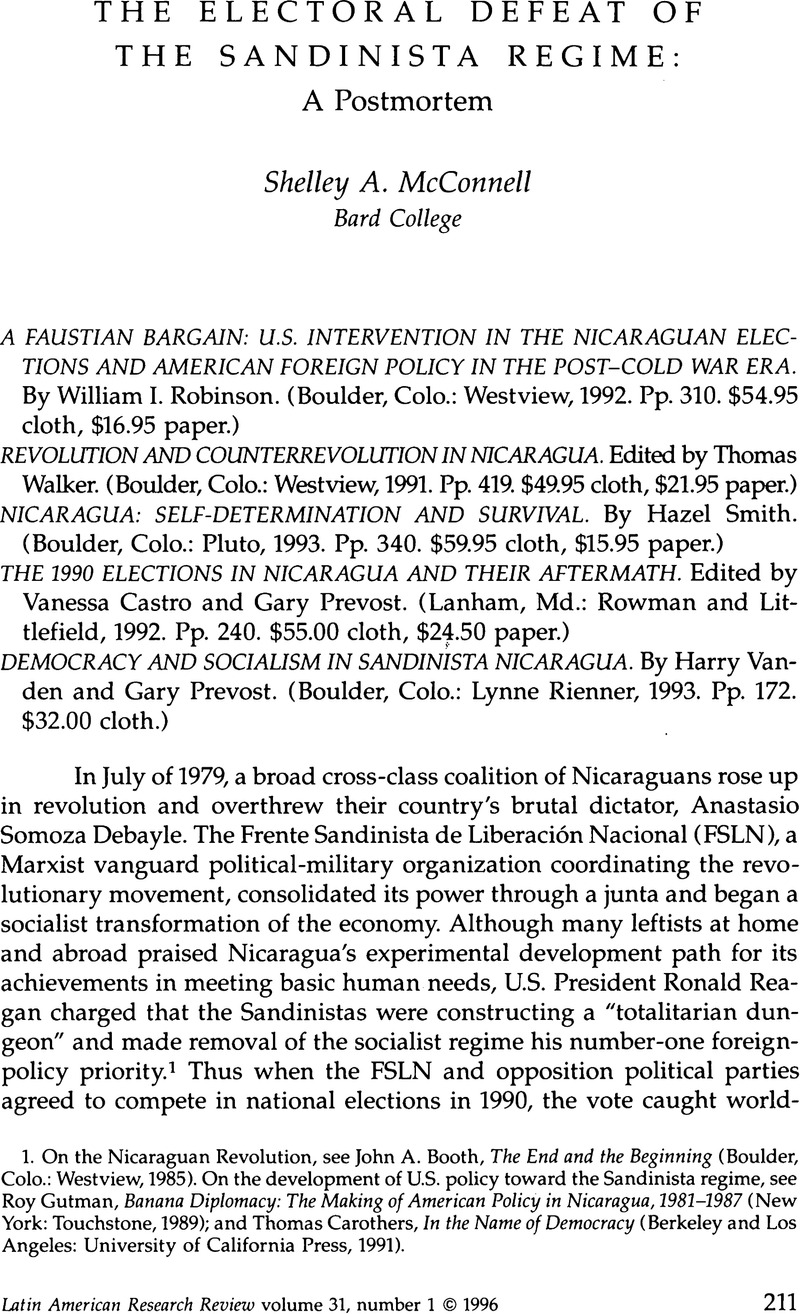Article contents
The Electoral Defeat of the Sandinista Regime: A Postmortem
Review products
Published online by Cambridge University Press: 05 October 2022
Abstract

- Type
- Review Essays
- Information
- Copyright
- Copyright © 1996 by the University of Texas Press
References
1. On the Nicaraguan Revolution, see John A. Booth, The End and the Beginning (Boulder, Colo.: Westview, 1985). On the development of U.S. policy toward the Sandinista regime, see Roy Gutman, Banana Diplomacy: The Making of American Policy in Nicaragua, 1981–1987 (New York: Touchstone, 1989); and Thomas Carothers, In the Name of Democracy (Berkeley and Los Angeles: University of California Press, 1991).
2. Additional titles not under review here include Oscar René Vargas, Adonde va Nicaragua (Managua: Nicarao, 1991); Guillermo Cortés Domínguez, La lucha por el poder (Managua: Vanguardia, 1990); Roger Miranda and William Ratliff, The Civil War in Nicaragua: Inside the Sandinistas (London: Transaction, 1993); and Alejandro Martínez Cuenca, Nicaragua: Una década de retos (Managua: Nueva Nicaragua, 1990).
3. See the FSLN's analysis of why it lost the 1990 election at its meeting in El Crucero in June 1990, published in Barricada in four segments beginning 16 June 1990. See also the appendices in the volume under review here edited by Castro and Prévost.
4. See Exporting Democracy: The United States and Latin America, edited by Abraham Lowenthal (Baltimore, Md.: Johns Hopkins University Press, 1991), especially the contributions by Paul Drake and Leslie Bethell.
5. For an electoral history of Nicaragua, see Oscar René Vargas, Elecciones en Nicaragua: Elecciones presidenciales en Nicaragua, 1912–1932 (Managua: Dilesa, 1989).
6. Some of the material in the Walker volume has been published elsewhere in similar form. See Peter Kornbluh, Iran-Contra Scandal: A National Security Archive Documents Reader (New York: Bowker, 1987); William Goodfellow and James Morell in Political Parties and Democracy in Central America, edited by Louis W. Goodman, William M. LeoGrande, and Johanna Mendelson Forman (Boulder, Colo.: Westview, 1992); and Gary Prevost's contributions in the Castro and Prevost collection under review here.
7. Walker is preparing a new and more closely edited volume on the Chamorro era that is expected to be published prior to the 1996 elections.
8. See Thomas W. Walker and John A. Booth, Understanding Central America (Boulder, Colo.: Westview, 1993).
9. The appendix to the volume contains copies in English of the statutes of the FSLN and “Principles and Political Programs,” both adopted at the First Congress of the FSLN in July 1991.
10. Factionalism is encouraged by Nicaragua's Ley Electoral and Ley de Partidos Políticos. They establish minimal requirements for founding a political party, a system of relatively pure proportional representation, minimal thresholds for obtaining a seat in the National Assembly, and equal allocation of money and media time to small parties.
11. For an update on the divisions within the FSLN, see the analysis offered in Envío: “The FSLN Congress: What's at Stake,” Envío 13, no. 155 (June 1994):16–18; and “A Rather Extraordinary Congress,” Envío 13, no. 156 (July 1994):10–13.
12. On the origins of Sandinismo, see Donald C. Hodges, Intellectual Foundations of the Nicaraguan Revolution (Austin: University of Texas Press, 1986).
13. Two good books on the mass organizations and their relationship to the FSLN are Gary Ruchwarger, People in Power: Forging a Grassroots Democracy in Nicaragua (South Hadley, Mass.: Bergin and Garvey, 1987); and Dennis Gilbert, Sandinistas: The Party and the Revolution (New York: Basil Blackwell, 1988).
14. The economic problems arising from the war and the U.S. embargo are the subject of The Political Economy of Revolutionary Nicaragua, edited by Rose J. Spalding (Boston, Mass.: Allen and Unwin, 1987).
15. The difficulty of retaining support after broadening the party base is discussed in Adam Przeworski and John Sprague, Paper Stones: A History of Electoral Socialism (Chicago, Ill.: University of Chicago Press, 1988).
16. Relevant works on transitions to democracy include Guillermo O'Donnell, Philippe C. Schmitter, and Lawrence Whitehead, Transitions from Authoritarian Rule: Prospects for Democracy (Baltimore, Md.: Johns Hopkins University Press, 1986); John A. Booth and Mitchell A. Seligson, Elections and Democracy in Central America (Chapel Hill: University of North Carolina Press, 1989); Samuel Huntington, The Third Wave: Democratization in the Late-Twentieth Century (Norman: University of Oklahoma Press, 1993); and Democracy in the Americas: Stopping the Pendulum, edited by Robert Pastor (New York: Holmes and Meier, 1989).
- 2
- Cited by




